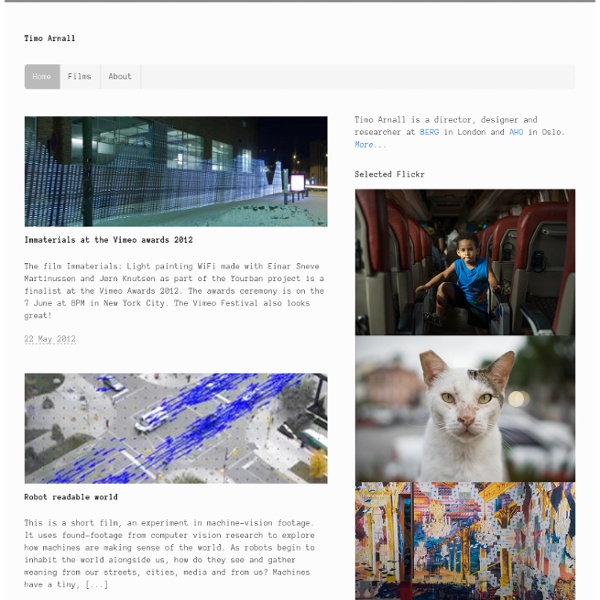



Facit Homes Designing for Embodied Interaction with Sound | Sound and Physical Interaction The development surrounding digital music interface (DMI) technologies have begun to con- sider embodied and enactive design approaches [1, 2]. This has largely been driven through the need to address ongoing problems that are common across many DMI’s [1, 3, 4]. This shift in design perspective is in following traditional Human Computer Interaction (HCI) which is now thought to be moving towards a third paradigm, which is considering phenomenological approaches within its practice [5]. This research intends to build on the work that has already been completed within the field that has centred on embodied and inactive approaches to the design and contraction of DMI’s and New Interfaces for Musical Expression (NIME). However the focus of this research will be centred around the user of such interfaces.
Can SF streetlights spy on you? rebecca@sfbg.com In the Netherlands city of Eindhoven, the streetlights lining a central commercial strip will glow red if a storm is coming. It's a subtle cue that harkens back to an old phrase about a red sky warning mariners that bad weather is on the way. The automated color change is possible because satellite weather data flows over a network to tiny processors installed inside the lampposts, which are linked by an integrated wireless system. Lighting hues reflecting atmospheric changes are only the beginning of myriad functions these so-called "smart streetlights" can perform. Each light has something akin to a smartphone embedded inside of it, and the interconnected network of lights can be controlled by a central command center. Since they have built-in flexibility for multiple adaptations, the systems can be programmed to serve a wide variety of purposes. LED streetlights are energy-efficient and could yield big savings — but the lights do far more than shine.
Interdisciplinary Xth Sense | Res, a matter. The Xth Sense is a biophysical musical instrument. With it you can produce music with the sound of your muscles. It is free and open source, and it was named the “world’s most innovative new musical instrument” by the Georgia Tech Center for Music Technology (US, 2012). You can build an Xth Sense and learn how to use it at one of the regular workshops taught wordlwide by the Xth Sense, creator Marco Donnarumma. The Xth Sense forum lives at Createdigitalnoise/xth, and you can connect with us on Facebook too. The XS amplifies the muscle sounds of the human body, and use them as control data and musical material. The software driving the system is written in Pure Data aka Pd. The XS biosensor is designed to be built by anyone. The XS is a free and open project. Schematic and Tutorial The Xth Sense DIY kit is also available for pre-order. Xth Sense, biophysical, wearable sensor. The Xth Sense Wearable Sensor (“The work”) is provided under the terms of this Creative (“CCPL” OR “LICENSE”).
The Future Of Surveillance Will Turn Society Into A Massive Online Game No matter what the future may contain, one thing is certain: just about everything in it, including us, will increasingly be under surveillance. Our habits, patterns, health, and preferences will be translated into data. Who will benefit from this valuable information, and how can we start developing the mindset to deal with this reality now? To get started, let’s filter a few core concepts and tough questions through our imaginations. Privacy The concept of privacy is relative, and it may be a luxury, but it’s good when people are able to relax, think, live and create without fearing that curiosity and exploration will come back to haunt them. Surveillance limits our freedom, but it could also allow us to save lives. If we could see such events before they escalate, what would we do about it? Behavior The story line in many games is that you are the hero and you fight your way up to the final battle against some evil character. Counterculture
fashion DJammer Overview The HP DJammer portable appliance could be the next generation of MP3 players. Building on top of current MP3 players, the HP DJammer has the following two additional functionalities: a personal DJ User Interface (UI), and a live digital session with one (or more) similar HP DJammer appliance enabling listeners to create music and digitally mix in real-time together (hence the term jamming). Various DJ UI are implemented with buttons, wheels and knobs similar to currently available MP3 players. Live digital jamming session is implemented using off-the-shelf wireless solutions such as 802.11 and Bluetooth. Presentation DJammer "HP digital launch" overview, September 2004. » Download .PDF file (2.27MB) Related articles DJammer wins Bronze 2005 IDSA IDEA award (June 2005) » Read the article DJammer featured in May issue of Maxim Magazine (April 2005) » Read the article (.PDF file, 150KB) DJammer featured in Wired News online article (March 2005) » Read the article
Urban Planning with Building Blocks and RFID Paint Brushes Next-Generation Building & Cityscape Modeling After being commissioned by Alexander the Great to lay out the city of Alexandria, the Greek Hippodamus (c. 407 BC) became known as the "Father of City Planning". My guess is he didn’t use a CAD system or RFID to help with his design. How times have changed. As mentioned in our post Construction Management with RIFD, RFID and sensors (RFIDS) are being integrated into building materials, enabling new Building Information Modeling (BIM) capabilities and allowing construction firms to use real-time data to enhance construction processes. According to a recent EE Times Europe story, researchers at the CEA-LETI (Electronics and Information Technology Laboratory of the French Atomic Energy Commission), are developing 3D interactive urban modeling tools using a combination of RFID and Microelectromechanical systems (MEMS) based motion capture technologies. [Photo credit: Gérard Cottet]
NorthernLight